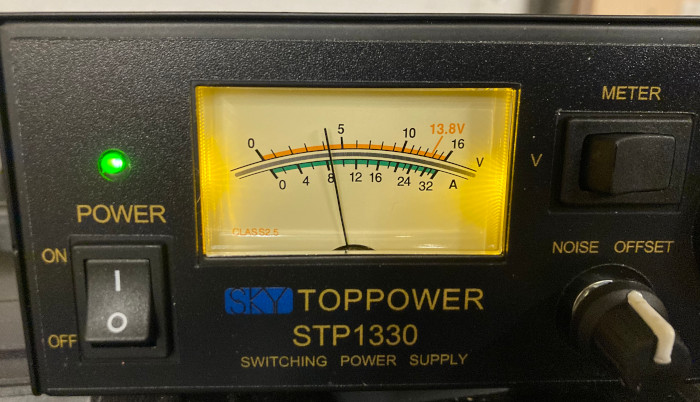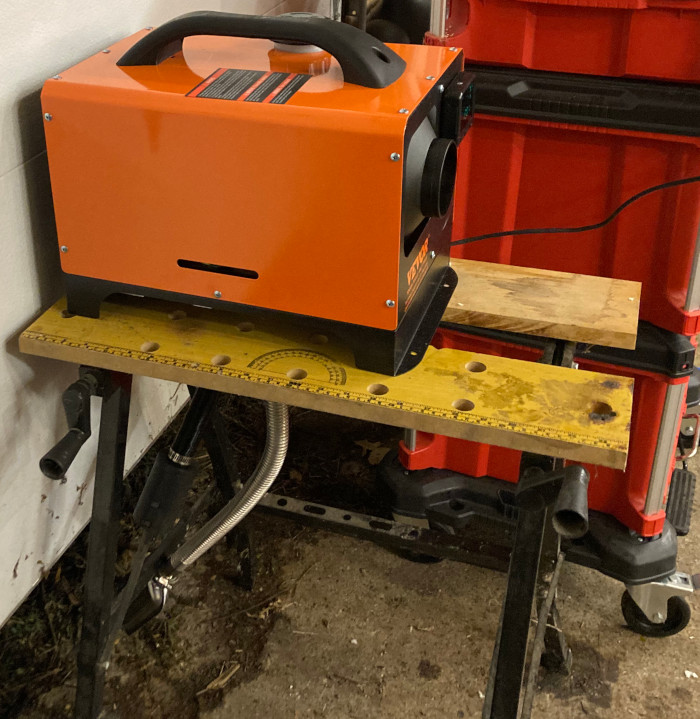My truck has two 12v batteries in series to make 24V. I know everyone is rushing to the keyboard to tell me I can work around that but I’ll stop ya’ right there. I decided to make it independent of the truck itself. After all, if I want to heat a tent or whatnot it can’t be hardwired to the truck. Also, I’m reluctant to unnecessarily draw power from the thing that is supposed to get me home. The truck doesn’t have a radio. (It did but that’s gone too.)
I wanted to power the heater with something like a Jackery Explorer 1000 but that’s not going to work for me.

(Note: I don’t own one of these. So don’t think I’m linking to Amazon because I’m recommending it. I lust after one, but I can’t vouch for it. The reason I went to Amazon is because I read the specifications in detail and it’s not up to snuff for the heater.)
The Vevor heater, and most like it (I think) draws 15 amps during the brief start up phase. Then it drops precipitously. The cool sexy power stations that people buy for camping seem to top out at 10 amps in 12v DC. That’s just how it goes.
Ironically, if you have a plain old stupid 12v deep cycle battery, you can pull 15 amps no problem. This is where some redneck with an electric trolling motor on his fishing boat has an advantage over a hipster who remotely charges his drone. Who knew.
Lucky for me, I’m a stupid redneck who tried an electric trolling motor on his homemade (!) sailboat. The battery is long dead but I still have the battery box. My battery box is the “deluxe” type. It has external terminals, a cigarette lighter port, and a battery tester. A fancy box will cost you about $50 (or did before inflation). My battery box is buried in my garage but here’s a photo of an equivalent box from Amazon.

It’s funny that a deep cycle in a box is better than a fancy power station. But it saves me money! I figure $50 (for the box, but really $0 because I own it) and a deep cycle 12V (who knows how much they cost in the Bidenverse but they used to be about $120). That’ll do what a $1000(!) power station can’t. I’ve seen various YouTubers complain that their camping power stations are too weak to handle the start cycle so I know the specifications matter.
I wanted to test it on AC. So I bought an AC to DC power supply. I didn’t really need this but I’m a HAM. A HAM is always needing another power supply. Most HAM power supplies top out at 10 amps. You’ve been warned. I purchased this:

This funky gadget is a Ham Radio Power Supply Analog DC Regulated 13.8V Fixed Output 30A Designed for Communication Equipment. (Don’t blame me, I don’t make up these names.) This was taken as the furnace was running, see that it’s pulling just over 8 amps? Most of the time the furnace is that low or even lower, but it did peak somewhere around 12 amps during start up. This is further evidence that the sexy power station would trip a breaker even though a plain old battery would be fine.
The point is, the power supply can plug into 120v AC and provide with all the 12v DC you’ll need. It’s enough to run enough radio equipment to get you put on a list. It’s enough for two (!) Vevor heaters. I’ll find a use for it long after the heater has been bolted into the truck.
My photo sucks, here’s one from Amazon. Notice that it has a cigarette lighter outlet and it says “Max 10A”? That’s because getting more than 10A in a cigarette lighter is not standard. That’s why people trying to run diesel heaters (at least some of which need more like 15 amps during start up) off a cigarette lighter get pissed off.

The back of the object is where the real power terminals live. You’ve got 30 amps on tap back there. Also, this little critter is smaller than it looks. It’s pretty sleek actually.

I wanted to be able to plug in and unplug the heater. I had a high amp 12V plug I got for a different project. It looks like this.

I took a million photos while I was setting it up but the photos are on another hard drive. Suffice to say, I put one plug end on the heater and made pigtails from the other end that hook to the AC/DC power supply OR a 12v deep cycle battery box. (I tested that the ring terminals fit.)
In case you’re wondering, I could plug the fancy AC to DC power supply into the AC port of a power station and that would almost certainly work. Turning battery power (inherently DC) to AC with a power station, just to go back to DC with a power supply… that would work. But it’s also an abomination.
The last part is not the least. It’s exhaust. I’m still working on it. For testing I just jammed it out of my garage door. I was impressed, once it’s warmed up and running, there’s hardly any exhaust. The exhaust is the silvery tube. It gets dang hot! The black cylinder is the air input for the combustion chamber. That stays cool. AIr intake for the heat is a vent at the back of the machine. Hot air output is at the front of the machine.
Combustion air and heat air are two different things. There’s no crossover. Properly vented, it won’t smell like exhaust and it won’t kill you off.

This is what my “testbed” looks like:

I’m not done yet, but I’ve got most of the pieces of the puzzle. The only thing holding me back is an (ironically) unheated garage. Wish me luck.

Did you put the “male” end of that high power plug on the heater, or on the power supply end? Should be on the heater end to avoid unintentional potential shorts/sparkems.
I think I did it the right way but now I’m afraid to check.
I always enjoy watching your projects come along.
I am interested in that hi amp connector you showed. Do you have the specs or a part number by any chance?
I have used Cole Hersee connectors on several projects but they max out at about 7 – 8 amps I believe. https://www.go2marine.com/Cole-Hersee-2-Pole-Connector A weather tight higher amp connector would be nice.
Speaking of hi amp dc connectors, have you looked in to Anderson Power Pole connectors? https://www.andersonpower.com/us/en/shop/wire-to-wire/powerpole/powerpole-15-45: html https://www.andersonpower.com/us/en/shop/wire-to-wire/powerpole/powerpole-15-45.html They are not weather tight, but very versatile and with the right wire gauge and contact size good up to 45 amps.
I’ll see if I can find the package of the plugs I have.
Look for MUYI 14AWG Electrical Connectors Kits, 3 Sets 2 Pin Way Wire Harness Connectors Weatherpack Connector Kit. They’re overkill for 99% of uses but I had some “higher power” installations I wanted to wire.
thanks!!
Add a decent 2500 watt inverter to the side of that battery box and you have the same thing as the Jackkery at about 1/3 the price, and likely more battery storage capacity to boot.
Of course it won’t be neat and tidy and slick to impress your hipster peers, so that might be a bonus….
B from MiddleOfTheRight.